Howdy, Neighbor!
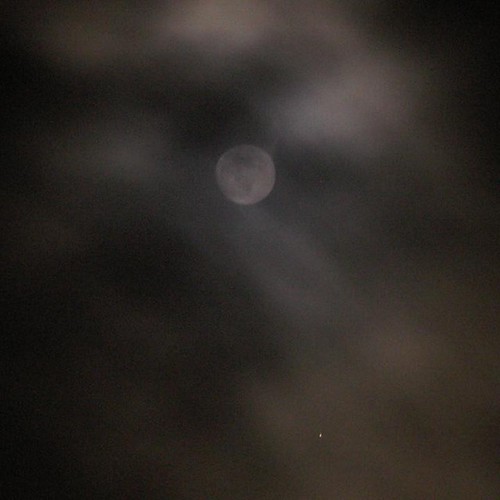
The Moon and Mars, about 4-1/2 hours prior to conjunction (their closest appearance to one another in the sky). Click on the photo to get a larger view.
I shot this on a 4-second exposure at f/8; except for cropping and compression it is as-is out of the camera. When I walked outside tonight I looked up into a quilted blanket of cloud cover -- solid except for a few threadbare spots. I was hoping to catch the moon and Mars in conjunction, but figured I'd settle for a moon-in-the-clouds shot. That is, if I could catch the moon peeking through....
Surprise! Not only did the moon peek through, enough to see a hint of mare, but that's Mars below and to the right, near the bottom of the shot. I whooped when I saw it on my computer screen.
Our Old Farmer's Almanac puts Mars at a "brilliant" magnitude -2.3 (beginning with its opposition on November 7) and says this is the planet's closest approach to Earth until 2018. Although the almanac adds, "The nearly full Moon joins Mars on the 14th," actual conjunction between the two doesn't occur until the 15th, when (according to Fact Monster) they will be 3 degrees apart at 1 AM EST (0600 UT). I took this shot at 8:36 PM.
The 15th is also the birthday of astronomer Sir William Herschel (1738-1822). According to SEDS (Students for the Exploration and Development of Space):
"On March 13, 1781 William Herschel discovered what he first thought to be a comet, but was later found to be planet Uranus. In recognition of this discovery, he was elected to the Royal Society on December 7, 1781, and awarded an annual grant by King George III of England, which enabled him to give up his career in music (on May 19, 1782) and concentrate on astronomy as the Court Astronomer of the King." Along with many other findings, Herschel discovered -- in about 2 decades time -- about 2,500 new nebulae and star clusters.
Maybe around 1 AM, if I'm still awake, I'll go see if the clouds have cleared.
Earlier today I dropped off a dummy copy and CD of a little booklet I put together reprinting some of my photos. Except for some collages and one photo I took at the art league 4-1/2 miles away, all the shots are of sights seen on my "post office walk." The brochure will be a little "thank you" to my clients up north.
Mary and I took another 6-mile walk on Sunday. One of the sights we passed was a "fairy ring" of mushrooms.
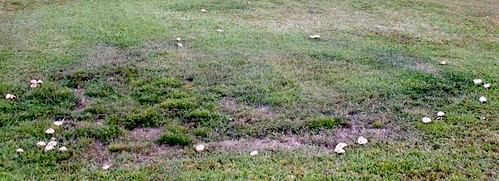
The following text comes from Zephyrus: Interactive Education on the Web:
"People have wondered about [mushroom circles] for hundreds of years and used to call them 'fairy rings' and believed elves and goblins danced round them at night. They believed it was lucky if a 'fairy ring' grew on your land. Today we believe that a 'fairy circle' started from a single spore. Each year the plant grows a little further outwards in search of more food. The mushrooms grow only on the outer part of the plant. So they grow ever outwards, in circles, in search of more food to eat."
The closest mushroom I've found to this is the Audubon Society Field Guide to Florida's Purple-Spored Puffball (Calvatia cyathiformis). Says the guide: "Round to pear-shaped, light brown ball narrows to stalk-like base; has cracked surface. Top breaks up and falls off to release spores." I'd call the dominant color here closer to white than light brown, but it's similar to what's in the book.
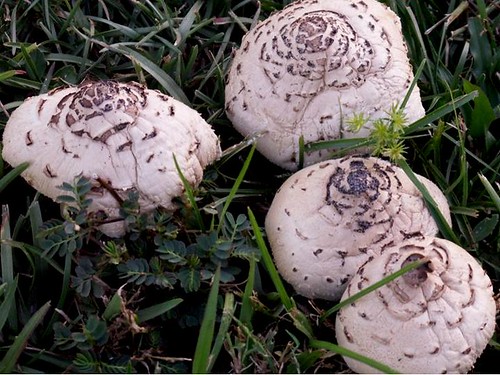
Mushrooms close-up
Mary was the one who noticed and identified the bagworm moth chrysalis attached to a long white fence.
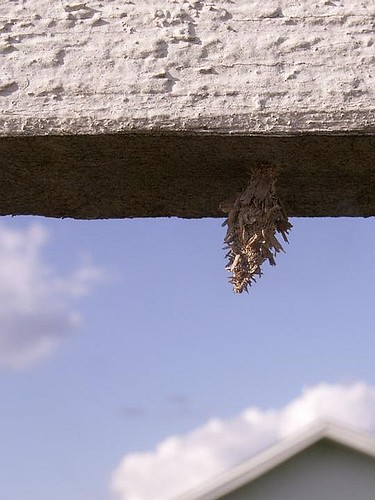
As we kept walking I spotted a second, and a third, and a fourth.... According to Bugguide.Net, larvae "drag around their case while feeding. When ready to pupate they attach the case with silk to a branch. Males squeeze their way out, often losing much of their wing scales in the process. They seek wingless, legless females who never leave their bag. The male inserts his abdomen to mate, and the female lays her eggs inside her own case. Eggs overwinter and after hatching they disperse and begin forming their own bags."
The moth wingspan ranges from 17-36mm, though bags may grow to 50mm. These moths range from Massachusetts south to Florida and west to Nebraska and Texas.
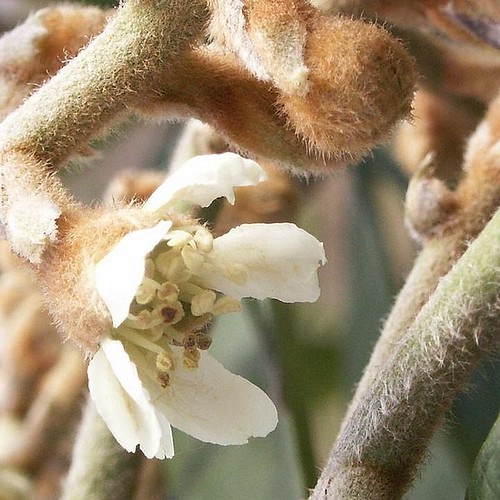
In our own back yard, the loquat I planted in the spring of last year has developed its first flower. I love the fuzz on this thing.
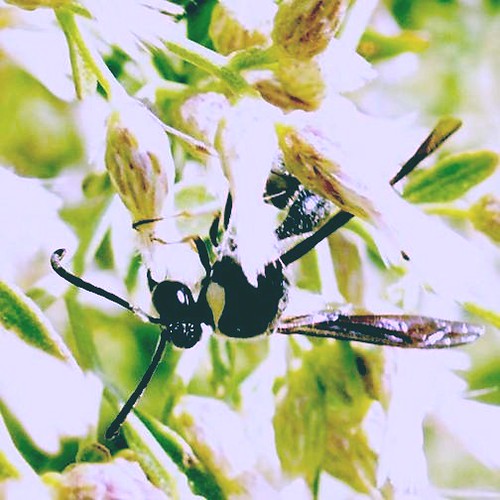
Our saltbushes have also begun to flower and now provide a handy wasp snack. These native plants were volunteers in our yard.
Sharon LaPlante of the Florida Native Plant Society writes, "The flowers are small, white or greenish and in compound heads. The male and female flowers are on separate plants (dioecious). White hair like bristles extend beyond the leafy bracts of the female flowers giving the plant a cottony, or silvery appearance. The bristles also help in dispersing the tiny seeds. The flowers appear in the fall at a time when few other plants flower."
Thanks to Bugguide.Net, I've identified the wasp as a Zethus (Eumenes fraternus). According to the Brackenridge Field Laboratory of the University of Texas, the Zethus is a Vespid (otherwise known as mason or potter) wasp, because most such wasps use mud in nest construction. Write Allan W. Hook and James M. Carpenter, "A few Zethus species build aerial nests made entirely of macerated leaves, plant fibers, and resins. This probably represents a major step in the evolution of nest type, as more advanced vespines make paper nests from plant fibers. Females are commonly collected at water and at soil sources of nest construction materials, whereas males are found patrolling these areas in addition to flowers."











2 Comments:
Wonderful shot of the night sky. Did you read where Polish archeologist think they found the bones of Capernicus?
And about mushrooms - I read somewhere (a long time ago) that the largest living thing on the planet was a mushroom. Some type that crops up here and there but shares a root system that goes for miles.
I have some fairy rings of grass in my yard. I wonder how they explain that?
Post a Comment
<< Home